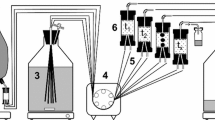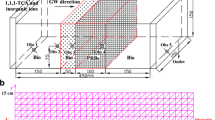Abstract
In situ biorestoration is a groundwater remediation technique in which the indigenous aquifer bacteria are stimulated by injecting compounds to provide carbon source and energy. Stimulated bacteria may transform the target contaminants such as tetrachloroethylene (PCE) and trichloroethylene (TCE) into intermediate products. In this study, we developed a model to simulate the substrate-limited biotransformation of the halogenated solvents present in anoxic groundwater by sequential reductive dehalogenation under methanogenic conditions. The model consists of conservation of mass equations for the primary substrate, immobile indigenous biomass, organic solvents such as PCE and TCE, and their intermediate products trichloroethylene, dichloroethylene, and vinyl chloride. The utilization of primary substrate and the biotransformation of organic solvents are assumed to follow Monod kinetics. The limiting factor on bacterial growth is assumed to be the primary substrate. The microbial yield coefficient is determined from the stoichiometric equation describing the anaerobic process. The model is solved by using a finite difference technique. Results are presented for three different case studies: continuous injection of primary substrate (acetate), single-pulse injection, and double-pulse injection. The single-pulse or double-pulse injection techniques were found to be more effective than continuous injection of primary substrate. Double-pulse technique reduces the clogging of injection wells caused by excessive microbial growth around boreholes and achieves a more uniform distribution of microbial growth in the subsurface. In all cases target compounds were effectively removed. The results, however, indicate substantial levels of intermediate product accumulation. Numerical results of a simplified model which assumes an abundance of primary substrate and a constant population of biomass, compare favorably with experimental data reported in the literature.
Similar content being viewed by others
References
Barrio-Lage, G., Parsons, F. Z., Nassar, R. S. and Lorenzo, P. A.: 1986, Sequential dehalogenation of chlorinated ethenes, Environ. Sci. Technol. 20(1), 96–99.
Bouwer, E. J. and Cobb, G. D.: 1986, Modeling of biological processes in the subsurface, Water Sci. Technol. 19(3).
Burmaster, D. E. and Harris, R. H.: 1982, Groundwater contamination: An emergency threat, Technol. Rev. 84(7), 50–62.
Corapcioglu, M. Y. and Haridas, A.: 1984, Transport and fate of microorganisms in porous media: A theoretical investigation, J. Hydrology 72, 149–162.
Corapcioglu, M. Y. and Haridas, A.: 1985, Microbial transport in soils and groundwater: A numerical model, Adv. Water Resour. 8(6), 188–200.
Corapcioglu, M. Y. and Hossain, M. A.: 1990a, Groundwater contamination by high-density immiscible hydrocarbon slugs in gravity-driven aquifers, Groundwater 28(3), 403–410.
Corapcioglu, M. Y. and Hossain, M. A.: 1990b, Theoretical modeling of biodegradation and biotrans-formation of hydrocarbons in subsurface environments, J. Theoret. Biol. 142, 503–516.
Corapcioglu, M. Y. and Hossain, M. A.: 1991, Estimating biotransformation rate constants for sequential reductive dehalogenation reactions, J. Environ. Eng. ASCE 117(5), 631–639.
Corapcioglu, M. Y., Hossain, M. A. and Hossain, M. A.: 1991, Methanogenic biotransformation of chlorinated hydrocarbons in groundwater, J. Environ. Eng. ASCE 117(1), 47–65.
Criddle, C. S., Alvarez, L. A. and McCarty, P. L.: 1991, Microbial processes in porous media, in: J. Bear and M. Y. Corapcioglu (eds), Transport Processes in Porous Media, Kluwer Acad. Publ., Dordrecht, pp. 639–691.
De Bruin, W. P., Kotterman, M. J. J., Posthumus, M. A., Schraa, G. and Zehnder, A. J. B.: 1991, Complete biological reductive transformation of tetrachloroethene to ethane, Appl. Environ. Microbiol. 58, 1996–2000.
Harvey, R. W., Smith, R. L. and George, L.: 1984, Effect of organic contamination upon microbial distributions and heterotrophic uptake in a Cape Cod, Mass, aquifer, Appl. Environ. Microbiol. 48, 1197–1202.
Hom, S. M.: 1991, Co-metabolism of chlorinated hydrocarbons, Bioremediation Rep. 1(1), 3–5.
McCarty, P. L.: 1984, Application of biological transformations in groundwater, Proc. Second Internat. Conf. Groundwater Quality Research, March 26–29, 1984, Tulsa, University Center for Water Research, Stillwater, Oklahoma, pp. 6–11.
McCarty, P. L., Semprini, L., Dolan, M. E., Harman, T. C., Tiedeman, C. and Gorelick, S. M.: 1991, In situ methanotrophic bioremediation for contaminated groundwater at St. Joseph, Michigan, in: R. E. Hinchee and R. F. Olfenbuttel (eds), On-Site Bioreclamation, Butterworth-Heinemann, Stoneham, MA, pp. 16–40.
Parsons, F. and Barrio-Lage, G.: 1985, Chlorinated organics in simulated ground water environments, J. Am. Water Works Assoc. 77(5), 52–59.
Roberts, P. V., Hopkins, G. D., Mackay, D. M. and Semprini, L.: 1990, A field evaluation of insitu biodegradation of chlorinated ethenes: Part 1, methodology and field site characterization, Groundwater 28 (4), 591–604.
Semprini, L., Roberts, P. V., Hopkins, G. D. and McCarty, P. L.: 1990, A field evaluation of in-situ biodegradation of chlorinated ethenes: Part 2, Results of biostimulation and biotransformation experiments, Groundwater 28(5), 715–727.
Semprini, L. and McCarty, P. L.: 1992, Comparison between model simulations and field results for in-situ biorestoration of chlorinated aliphatics: Part 2, Cometabolic transformation, Groundwater 30(1), 37–44.
Vogel, T. M. and McCarty, P. L.: 1985, Biotransformation of tetrachloroethylene to trichloroethylene, dichlorethylene, vinyl chloride, and carbon dioxide under methanogenic conditions, Appl. Environ. Microbiol. 49(5), 1080–1083.
Wilson, J. T. and McNabb, J. F.: 1983, Biological transformation of organic pollutants in groundwater, Trans. Am. Geophys. Union 64(33), 505.
Wilson, J. T., Leach, L. E., Henson, M. and Jones, J. N.: 1986, In situ biorestoration as a groundwater remediation technique, Groundwater Monitoring Rev. (Fall 1986), 56–64.
Woods, B. D., Ginn, T. R. and Dawson, C. N.: 1995, Effects of microbial metabolic lag in contaminant transport and biodegradation modeling, Water Resour. Res. 31 (3), 553–563.
Author information
Authors and Affiliations
Rights and permissions
About this article
Cite this article
Hossain, A., Corapcioglu, M.Y. Modeling primary substrate controlled biotransformation and transport of halogenated aliphatics in porous media. Transp Porous Med 24, 203–220 (1996). https://doi.org/10.1007/BF00139845
Received:
Revised:
Issue Date:
DOI: https://doi.org/10.1007/BF00139845




